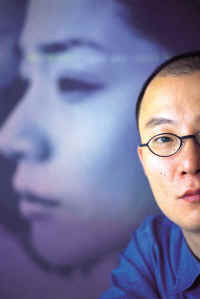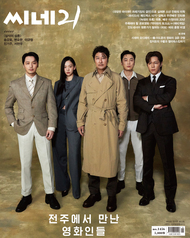제 영혼이 낯설어서 온 세상이 타향인 숙명적 ‘이방인’들. <이방인>의 문승욱 감독은, 4년만에 만든 두 번째 영화 <나비>에서 그들의 비망록을 다시 한 번 들춘다. 망각의 바이러스를 구하던 여자가, 곪은 기억도 불완전한 생명도 간직하려는 소녀를 만나 겪는 변화를 그린 영화 <나비>는, <이방인>보다 더 깊이 삶의 눅눅한 속살에 손톱을 박는다. 토론토, 로카르노로 이어지는 영화제 초청장을 받아들고도, <나비>가 관객의 품에 날아들지 근심을 거두지 못하는 문승욱 감독(33)을 만났다.
<나비>는 현재 상업 영화 시스템이 용인하기 힘든 영화다. 독특하고 재미없는 영화에 관심 많은 제작자를 만나서 가능했다.(웃음) 신생 영화사에 스타도 없고 스탭 규모도 작아 어려움이 많았는데 부산영상위원회가 고베 영상위원회를 소개하는 등 큰 도움을 줬다.
기억의 문제는 미래영화의 단골소재인데, 부담스럽지 않았나. 당시엔 할리우드 영화를 많이 못 봐 그런 생각을 못했다. 1999년 수해가 있었다. 첫 영화에 실패한 나는 살아갈 길을 막막해 하며 빗줄기를 바라보고 있었다. 김현의 책들을 읽던 무렵이었다. 물에 소중한 기억을 쓸려보내는 이웃의 모습을 보면서 과거와 단절돼 살아가는 한국인, 동양인들은 기억상실증에 걸려있을 지도 모른다고 생각했다.
즉흥 연출로 보이는 장면이 있다. <나비>가 ‘마지막’ 영화일 지도 모른다고 생각했다. 그래서 두 가지 ‘원칙’을 지키려고 노력했다. 시나리오를 일단 쓰지만 촬영에 들어가면 잊어버릴 것. 카메라는 배우를 뒤따를 것. 여기엔 배우들의 도움이 절대적이었다.
디지털 촬영에 관해. 영화학교 동료들의 영화에서 근거 없는 롱테이크 때문에 배우가 카메라의 노예 혹은 노리개가 되는 모습을 보며 괴로웠다. 그래서 카메라가 배우가 가는 곳을 어디든 따라가는 디지털 작업에 이끌렸다. 피터 그리너웨이의 최근작 정도는 ‘디지털 영화’로 언급될 가치가 있지만, 대체로 디지털은 ‘누벨 바그’와 별다르지 않다고 본다. 카메라가 더 작아졌을 뿐.
부산과 고베 풍경에서 미래 공간을 만들어냈는데. 늘 공사 중인 부산이 지닌 황폐함, 지진으로 재건된 고베의 무국적적 미니멀리즘을 담으려 했다.
3명의 주인공, 기존 인간 관계에서 떨어져나온 사람들의 ‘스침’을 즐겨 다룬다. 스스로 떠돌며 살았고 내가 제일 좋아하는 단어가 ‘노마드(유목민)’다. 내가 좀 모범생 기질이 있는데 좋은 영화들을 보니 다 주인공이 셋이더라. <줄과 짐> <안개 속의 풍경>을 봐라.(웃음)
김혜리 기자
“Digital, No Different from’Nouvell Vague’”
? director Mun Seung-wook
To those who find their own souls unfamiliar, not a single place on earth seems to be called home to these destined ?trangers? The director of , Mun Seung-wook, opens their memorandum again with his 2nd film , in 4 years. , a film that draws the changes a woman (in search for an oblivion virus) goes through by meeting a girl who refuses to throw away the festered memories. This film digs its fingernails deeper into life? inner skin than does.
is a film that the current commercial movie industry finds hard to accept. It was possible because I met a producer who was interested in a unique and boring film(with a smile). There were no big stars at the new film production and not many staff members, but the Pusan Film Commission introduced us the Kobe Film Commission, which was a big help.
Issues dealing with memory are a frequent subject in future films, didn? that fact bother you? I wasn? watching a lot of Hollywood films back then, so nothing of the sort came to my mind. There was a big flood in 1999. I was staring at the streaks of rain while in despair. My first movie was a failure and there seemed to be no way to put my life back on track. By looking at my neighbors trying to wash away the dreadful memories in the flood, I thought that those Koreans, Asians who live a life alienated from the past might have amnesia.
There is a scene that looks like it was improvised. I thought could be my ?ast?film. So I tried to abide by two ?rinciples? One, to write the sce-nario but forget about it once the cameras start rolling. And two, make the camera follow the actor/actresses. Of course, they played a key role in this.
About the digital shooting. I was very disappointed with the films of my co-lleagues from film school. The sight of the actors becoming slaves of the camera or its plaything due to a groundless long take made me sick. That? why I was drawn to the idea of the camera following the actor. Peter Greenaway? recent films are worth bringing up as a ?igital film? but I think that digital films are no different from ?ouvelle vague? Only the size of the camera got smaller.
The 3 main characters, you take a fancy in drawing peculiar people brushing past one another. I myself roamed around and I like the word ?omad?best. I? kind of a Mr. goody two shoes, and look at all the good films like ! They all have 3 main characters.




